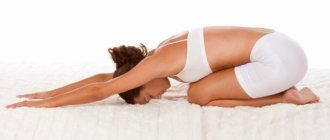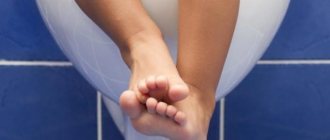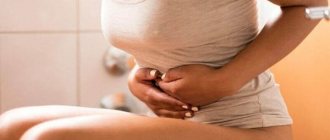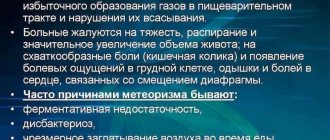Exercises for constipation in older people are an integral part of the prevention of this pathology. It allows you to eliminate existing problems and prevent the emergence of new ones. Of course, gymnastics in the generally accepted sense is not suitable for all older people due to age-related changes in the musculoskeletal system and the presence of concomitant diseases. In this regard, these patients are recommended special exercises that will help restore tone to the gastrointestinal tract and the entire body.
Exercise and constipation
The well-known fact of the positive impact of sport on the human body is no secret.
Regular, dosed physical exercise of moderate intensity helps to tone the muscles of the body, normalize a person’s well-being and strengthen the body’s defenses.
Intestinal problems in elderly or young people, which are accompanied by the development of constipation, can also be successfully eliminated with the help of a properly selected set of exercises.
The main positive effects on the functioning of the gastrointestinal tract in older people that regular exercise has are:
- Stimulation of peristaltic movements. Considering that in most cases, problems with defecation are functional in nature due to a decrease in the tone of the organ wall, activation of motor skills through physical activity can quickly eliminate the problem.
- Improved metabolism. Constant training leads to stabilization of the processes of absorption of nutrients and their transport into the bloodstream. Against this background, the functioning of the entire gastrointestinal tract is stabilized.
- Increased body tone and acceleration of all metabolic processes. Physical activity has a complex effect on the entire human body. They are useful both for the intestines and for the heart, brain and other organs and systems.
Dosed physical exercise is recommended for almost all people. For pensioners, they are especially relevant in the fight against constipation, correction of blood pressure and blood sugar levels.
Of course, you need to understand that a pensioner does not need to attend a gym or any specialized classes to normalize the functioning of the gastrointestinal tract. It is enough to perform a set of simple exercises every day that will help activate intestinal motility.
Belly breathing to normalize digestion
People of all ages suffer from impaired intestinal motility. For pregnant women and nursing mothers, the elderly, the use of pharmacological agents is undesirable
.
But recipes based on medicinal herbs do not always bring results
. Therefore, exercises for constipation in adults are gaining popularity.
Without physical training, with weakness, hypertension, low muscle tone, breathing practices will be an ideal option. There are many of them in oriental medicine, yoga and Ayurveda
. In the modern world, they are at the peak of popularity due to their availability, lack of contraindications, and effectiveness. Examples are easy to find on the Internet or on specialized forums.
Let's consider what exercises eliminate peristalsis disorders at home.
Physical exercises for constipation from breathing practice work with the abdominal muscles, diaphragm, connective tissue of the perineum and pelvic floor. Therefore, this technique has a positive complex effect on the entire body.
Simple rules will help you do the exercises correctly for maximum effectiveness:
- lie down on a hard surface;
- the state should be calm, do all exercises slowly, focusing not on the result, but on the process;
- the best time to practice: immediately after waking up or before bed;
- 10 approaches are required for results.
Let's look at other examples. As you inhale, pull in your stomach sharply and as much as possible
.
Gently relax your muscles as you exhale. While inhaling, hold the retracted stomach in a tense state for 10 seconds
.
Then release the air sharply. Such training will be the best prevention of stagnation in the intestines, prolong youth, and normalize blood pressure
. For a positive result, the main thing is to regularly do the whole complex.
Morning exercises
Not all older people have the opportunity to play sports in the traditional sense of the word. Age-related changes in joints, muscles, and the whole body can become an obstacle to such activity.
There are a number of simple exercises that can help relieve constipation in older people. These exercises will help quickly and efficiently improve the functioning of the intestines and the entire gastrointestinal tract.
Doctors recommend doing morning exercises. It should be done before breakfast. It is advisable to drink a glass of cool water 30 minutes before the start of your workout. It will contribute to additional stimulation of peristaltic movements.
A few simple exercises should be included in your morning exercise routine:
- tilting the body in different directions;
- lunges;
- pelvic turns;
- squats.
Each elderly person regulates the intensity of exercise for himself. You cannot force a person to exhaust himself with exercises if he has joint pain or is undergoing rehabilitation after undergoing surgery.
However, you shouldn’t ignore morning workouts either. They gently activate intestinal peristaltic movements and help relieve constipation.
Benefits and contraindications
Following the principles of exercise therapy for prolapse of the stomach and intestines can:
- improve organ function;
- eliminate flatulence;
- relieve the patient from constipation;
- reduce pain symptoms;
- reduce the intensity of heartburn;
- stabilize the general condition;
- prevent the development of complications, etc.
However, you can begin to perform daily therapeutic exercises only after a complete examination of the body, since there are certain contraindications to it.
You cannot do some exercises if there is severe inflammation or an infectious process in the abdominal organs.
It is not recommended to perform gymnastics for persons suffering from pathologies of the heart or blood vessels.
If you have intestinal prolapse, you should not do exercises that involve sudden movements, otherwise organs may be pinched.
With the development of tumor processes or varicose veins of the small pelvis, gymnastics is completely contraindicated.
Advanced hemorrhoids require full treatment and avoidance of any exercises that can aggravate the symptoms of the disease.
After surgery, heart attack or stroke, gymnastics is postponed until the end of the rehabilitation period.
Massage
One of the simple and effective methods of eliminating constipation is self-massage of the abdomen. It can be performed in almost any situation and does not require particularly deep knowledge of anatomy or physiology.
The mechanism of its mild laxative effect is very simple - physical stimulation and kneading of the anterior abdominal wall is transmitted to the intestines, which reflexively begin to contract faster.
In some cases, you can even partially independently move stagnant feces along the gastrointestinal tract.
It is only important to remember the methodology for performing self-massage. It is carried out with one hand using stroking and kneading movements. The process of manual influence should always be carried out clockwise, according to the movement of the food bolus through the gastrointestinal tract.
You need to start from the right iliac region. Then move in a circular motion from the right half of the abdomen, through its center and to the left. The end point is the left iliac region.

It is important that your hand is warm during the massage. You can first use a heating pad to enhance microcirculation in the area of treatment and increase the effectiveness of the procedure.
The massage can also be performed by another person. Sometimes special oils are used to carry it out. However, given the purpose of the procedure, the use of auxiliary aids is not mandatory.
Benefits of exercise for constipation
Constipation in most cases occurs as a result of poor nutrition and decreased activity of intestinal motility. The movement of a bolus of food through the intestines becomes difficult not only if the diet is incorrectly selected, but also if a person moves little.
Physical exercises for the intestines, performed regularly, will allow you to achieve a reduction in the effect of physical inactivity on the intestines. Under their influence the following changes occur:
- blood circulation in the pelvic organs improves;
- strengthens the abdominal muscles;
- metabolic processes improve.
Gymnastics will allow you to eliminate constipation, thereby avoiding taking laxatives. Specially selected physical exercises should be combined with increased general physical activity throughout the day.
If you are prone to constipation, the following are useful:
- walking long distances;
- jogging;
- swimming;
- cycling and skiing;
- tennis.
When choosing the type of physical activity, take into account age, place of residence, habits, general well-being, and family traditions.
Remember: Exercise will not help you if constipation is a manifestation of certain diseases. In case of chronic stool retention, especially if it occurs while taking measures to prevent poor bowel function, you need to undergo an examination.
Walking
If we evaluate the effectiveness of many exercises that are suitable for older people suffering from constipation, then ordinary walking remains one of the most relevant and effective. It is enough to walk 3-5 km at a normal walking pace per day.
Staying in the fresh air, combined with such simple physical activity, has a complex effect on the human body. Elimination of constipation in older people in this case occurs due to:
- Activation of gastrointestinal motility. The anterior abdominal wall constantly contracts during movement and has a similar effect on the large and small intestines.
- Strengthening lung ventilation. They expand more than usual, which puts additional pressure on the diaphragm. It, in turn, also contracts and gently massages the intestinal loops from above, providing stimulation of their own motility.
- Strengthening microcirculation. Regular walking, like any other physical activity, ensures a flow of fresh blood to almost all organs and systems, enhancing their functional activity. This is also true for the intestines.
In addition to its positive effect on gastrointestinal motility, walking is especially important for older people due to its ability to stabilize blood pressure, reduce sugar levels and “bad” cholesterol in the blood.
Since very often people over the age of 60 have certain problems with metabolism, the natural opportunity to improve their health through regular walking is a simple and affordable method of normalizing well-being.
Preparing for a massage for a child
Before performing a abdominal massage, it is necessary to create all the conditions for its implementation so that the undressed baby does not freeze and feels comfortable.
- There should be no drafts in the room.
- The optimal indoor air temperature is 23 °C.
- Abdominal massage for constipation should be carried out on a hard surface, for example on a changing table or sofa, where you should first lay a blanket or terry towel, and an oilcloth on top.
- Tummy massage should be done using emollients (baby oil or milk), which make it easier for your hands to glide over the baby's skin.
- Before the procedure, you need to wash your hands and, if necessary, warm them in hot water. The child will not like the touch of cold fingers, and the session will not be beneficial.
Complexes of physical exercises
When it comes to selecting a set of exercises to eliminate the problem of constipation, it is important to consider what type of constipation has developed in a particular person. There are two main types of corresponding pathology:
- Atonic constipation. Caused primarily by insufficient force of contraction of the muscular wall of the intestine with a decrease in the activity of peristaltic movements. Stool moves too slowly or does not move towards the anus at all.
- Spasmodic constipation. Caused by spasm of the intestinal muscles. This may cause partial narrowing of the lumen of the organ or the impossibility of its normal functioning.

Exercises for atonic constipation
In the first case, exercises should be aimed at stimulating the organ’s own motor skills. They are mainly dynamic in nature. Elderly people cannot perform too heavy loads, so effective exercises to eliminate atonic constipation are:
- "Bike". While lying on your back, you need to “turn” imaginary pedals of the corresponding vehicle. Due to the activation of the abdominal muscles, a reflex increase in intestinal motility occurs.
- In a lying position, you should try to pull both legs one by one or simultaneously to your chest and, clasping them with your hands, hold them for a few seconds and then release.
- In a lying position, try to throw your straightened legs behind your head. This exercise is quite difficult for many older people, so you can limit yourself to simply raising your straight legs to waist level.
- In the knee-elbow position, you need to rhythmically draw in and protrude your stomach. It is very important in this case to breathe deeply for additional massaging of the intestines with the diaphragm.
- "Cat". In the knee-elbow position, you need to alternately bend your lower back as much as possible, throwing your head back, and then make your back round.
- In a standing position, rotate your torso and bend to the sides.
The elderly person must determine the number of times each exercise should be performed for himself. Most often, 10-20 repetitions are performed, however, a lot depends on your general well-being.
Exercises for spastic constipation
Spastic constipation is relatively less common in older people. It is eliminated with the help of relaxing and slow exercises that help reduce muscle spasm.
Various stretches, slow bends, and yoga can be effective in this regard. To select a set of exercises to eliminate spastic constipation, it is better to first consult with your doctor.
Causes of prolapse of the intestines and stomach
Gastro- and enteroptosis usually occurs due to a number of unfavorable factors.
The first place among them is physical inactivity, as well as the associated lack of physical preparation of the patient, which causes lethargy of his abdominal muscles.
Diseases of the respiratory system make a significant contribution to prolapse of the stomach or intestines.
Of particular importance is the performance of extensive abdominal operations on the digestive organs, injuries or wounds to the abdominal cavity, as well as multiple pregnancies or repeated births.
An unhealthy diet, heavy daily physical activity, and excessive exercise have an adverse effect on the gastrointestinal tract.
The cause of gastro- and enteroptosis can be sudden weight loss or, on the contrary, obesity of the patient. Genetic predisposition also plays a major role in the development of pathology.
Swimming
Swimming and water aerobics are the most effective methods for relieving any type of constipation in older people. Water procedures are a universal physical activity that allows you to strengthen the entire body and improve the functioning of the gastrointestinal tract.
The main positive effects that this type of activity has on the human body remain:
- Mild stimulation of intestinal motility. Water itself acts as a kind of massager. In combination with the involvement of all muscle groups, it is possible to quickly solve the corresponding problem.
- Toning the whole body. During swimming, almost all muscles work. Against this background, energy consumption increases. To provide the body with nutrients, food processing processes are activated in the intestines, accelerating its evacuation.
- Lung development. They swell more strongly and gently massage the diaphragm and intestines.
In addition, swimming is an excellent anti-stress factor, which will normalize not only somatic, but also psychological health of a person. That is why it is recommended to almost all people, regardless of age.
To eliminate constipation, it is enough for an elderly person to visit the pool at least 1-2 times a week.
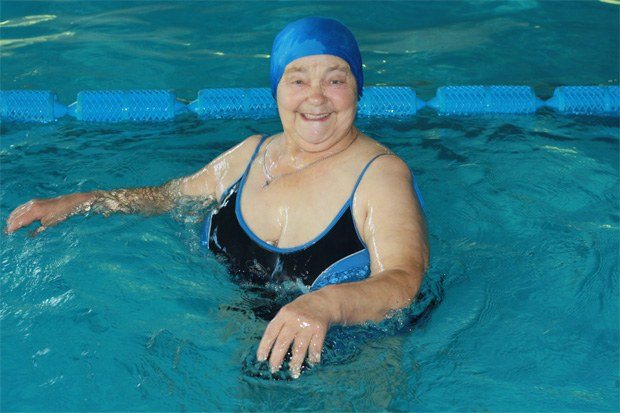
Gymnastics for constipation in children
Stool disorders in childhood are quite common. An unformed body does not always cope with food, and the abdominal muscles are poorly developed
. Gymnastic exercises in combination with massage help cope with constipation in the first years of a child’s life.
Following the recommendations of specialists ensures achievement of a positive result in a short time
Every day parents should perform the following movements:
- slowly stroke the baby's tummy clockwise for 1 minute;
- cross your arms and stroke your stomach from top to bottom;
- stroke the tummy with your palms from the sides to the navel and in the opposite direction;
- lightly rub the abdominal area with your knuckles (do not press), moving around the navel;
- bend the legs and pull them towards the stomach, straighten them;
- Do pull-ups similar to the previous exercise on each leg separately;
- Gently turn the legs bent at the knees to the sides;
- pull the bent left leg towards the elbow of the right arm and vice versa;
- Raise the straight legs at a right angle, hold them and lower them smoothly.
The exercises are performed in the sequence described, slowly, smoothly, with warm hands, repeating no more than 3-5 times. The baby should be calm; if he is capricious, gymnastics should be postponed
. Older children can do the same set of movements, but independently or partially with the help of their parents. It is very important that, along with gymnastics, the child eats healthy food and drinks enough fluids.
Combination of exercise and diet
Exercise is a great way to solve the problem of constipation. However, it is not a panacea and cannot guarantee a 100% positive result.
It is effective only in a comprehensive fight against constipation with the parallel use of other methods to normalize the functioning of the gastrointestinal tract.
A prerequisite for strengthening intestinal motility against the background of regular physical activity is maintaining a proper diet. There are several simple recommendations that will increase the effectiveness of your training.
These include:
- Eat often, but in small portions. This will reduce the functional load on the intestines, which will speed up the process of evacuation of feces.
- Drink at least 1.5 liters of water per day. This item should be performed with caution in elderly people with kidney or heart disease. It is better to consult your doctor first.
- Introduce fiber-rich foods into your diet (fresh vegetables, fruits, bran).
- Eliminate fatty, fried, smoked and other hard-to-digest foods from the menu.
If you do not forget about these nutritional rules along with regular dosed physical activity, you will be able to eliminate constipation and prevent its reoccurrence very quickly.
Why is constipation dangerous?
Constipation is a bowel condition where there is a delay in bowel movements for more than two days or difficulty during bowel movements. Normally, a healthy person should have stool every day, the stool should be homogeneous, without a foul odor. Irregular bowel movements, alternating constipation and diarrhea, and abdominal discomfort during toileting indicate disturbances in bowel function.
There are two types of constipation:
- atonic – absence of bowel movements for more than 3 days due to decreased intestinal tone and poor peristalsis, feces are dense and heterogeneous, pass through the rectum with difficulty, causing pain and cracks;
- spastic - defecation occurs against the background of intestinal spasms, feces are excreted in small portions (“sheep feces”) and irregularly.
The reasons for defecation disorders can be different:
One of the unpleasant human conditions is constipation.
- poor nutrition;
- insufficient water consumption;
- nervous tension;
- low physical activity;
- diseases of the gastrointestinal tract, intestines;
- autonomic disorders.
In any case, the condition brings discomfort, pain in the abdomen, heaviness and bloating. Well-being worsens, appetite is lost, performance decreases, irritability and fatigue appear. With prolonged constipation, general intoxication, increased body temperature, and the development of dysbacteriosis are possible
.
All this has a bad effect on your physical and psychological state
. Timely and adequate measures to cleanse the intestines are required.
Precautions
Despite all the effectiveness and safety of training to normalize intestinal function, you need to understand that there are situations in which it is worth limiting physical activity. These include:
- uncontrolled arterial hypertension;
- severe forms of ischemic heart disease;
- recent myocardial infarction or stroke;
- suffered severe injuries;
- general serious condition of the patient.
In any case, you should consult your doctor about the advisability of physical activity.
Rules for performing abdominal exercises for constipation
The most effective restoration of intestinal function is possible only with the correct exercise technique and following simple rules:
- gymnastics is done regularly, preferably daily;
- exercises are performed an hour before meals or 2 hours after meals;
- a state of calm and concentrated on sensations;
- breathing is even and rhythmic, with alternating inhalations and exhalations;
- exercises bring pleasant sensations, but not discomfort and pain;
- physical activity is contraindicated in acute hemorrhoids, hypertension, heart pathologies, peptic ulcers - it is better to practice breathing and self-massage.
Exercising for constipation certainly helps to cope with the problem and improve your well-being. But do not forget about a balanced diet and sufficient drinking regime
. If you have prolonged problems with bowel movements (more than a week), you should consult a doctor.
